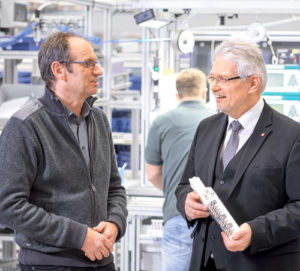 Taking the guesswork out of condition monitoring, operation and maintenance tasks can be done with Aventics Smart Pneumatics Monitor, which offers data acquisition and control of critical components within a pneumatics system.
Taking the guesswork out of condition monitoring, operation and maintenance tasks can be done with Aventics Smart Pneumatics Monitor, which offers data acquisition and control of critical components within a pneumatics system.
Using a valve bank that communicates via an I/O Link with sensors on the cylinder, pressure sensors, pressure regulators and other sensors, users are able to anticipate wear before it leads to machine downtimes. This allows early detection of when critical limits will be reached and enables predictive maintenance.
Erl Campbell, ??? said that this sensor-driven system means you can measure system flow, pressure, how many times a valve shifts, cylinder travel, and even shock absorber compression. “With all that data, we’re working outside the control, connecting to a laptop, computer, or wirelessly and then we can put it on a dashboard for lifecycle or maintenance.”
For example, when Campbell showed this technology to me at PackExpo, he was able to demonstrate the effects a system leak would have. By introducing a leak into the system, you can see in real-time the effects it had and how that will impact life cycle.
While other solutions collect all available data and transfer it unfiltered, the Aventics electronic module evaluates the data locally and uses it to generate information about the status of the system. Via drag-and-drop on a graphical interface, users define the components of the pneumatics system they want to evaluate. Once defined limits are reached, the electronics automatically send messages to ERP and MES systems, as well as maintenance technicians or other staff. The Smart Pneumatics Monitor thus supports predictive maintenance concepts and helps to increase system availability as well as reduce maintenance costs.
The limits defined in the software are based on Aventics’ many decades of application experience. This provides users with the advantages of predictive maintenance directly without having to define tolerance ranges or limits themselves.
Moreover, the sensor data collected via the I/O modules also enables monitoring and optimization of the pneumatic systems’ energy efficiency. The electronics use pre-installed algorithms to process data such as the pressure and flow in the maintenance units. This data can be used to generate and regularly transmit energy reports for the monitored systems. The Smart Pneumatics Monitor also issues warnings if limits are exceeded or irregularities are detected.
In addition, the Smart Pneumatics Monitor can directly transfer all collected data via standard Ethernet to upstream devices such as PCs or servers. This prevents the machine or system control from an overload of data traffic that would negatively impact its performance. Aventics delivers the module with an integrated OPC UA server, one of the first globally accepted IoT standards for machine-to-machine communication, and supports the widely applied MQTT format. For individual requirements, the Smart Pneumatics Monitor can also be tailored to customer-specific applications.
This is all just part of IoT or Industry 4.0, Campbell said. “With all the data we’re collecting, at the end user level, they have to figure out to take all this data and how do you make a nice picture of the machine and look for the areas you have to look at,” he said. “It takes some of the guesswork out, so rather than replacing the whole valve manifold, you can just a specific valve, etc. It allows for easier planned shutdowns.”
Aventics
www.aventics.com/us
Filed Under: Pneumatic Tips, Sensors, Slider
